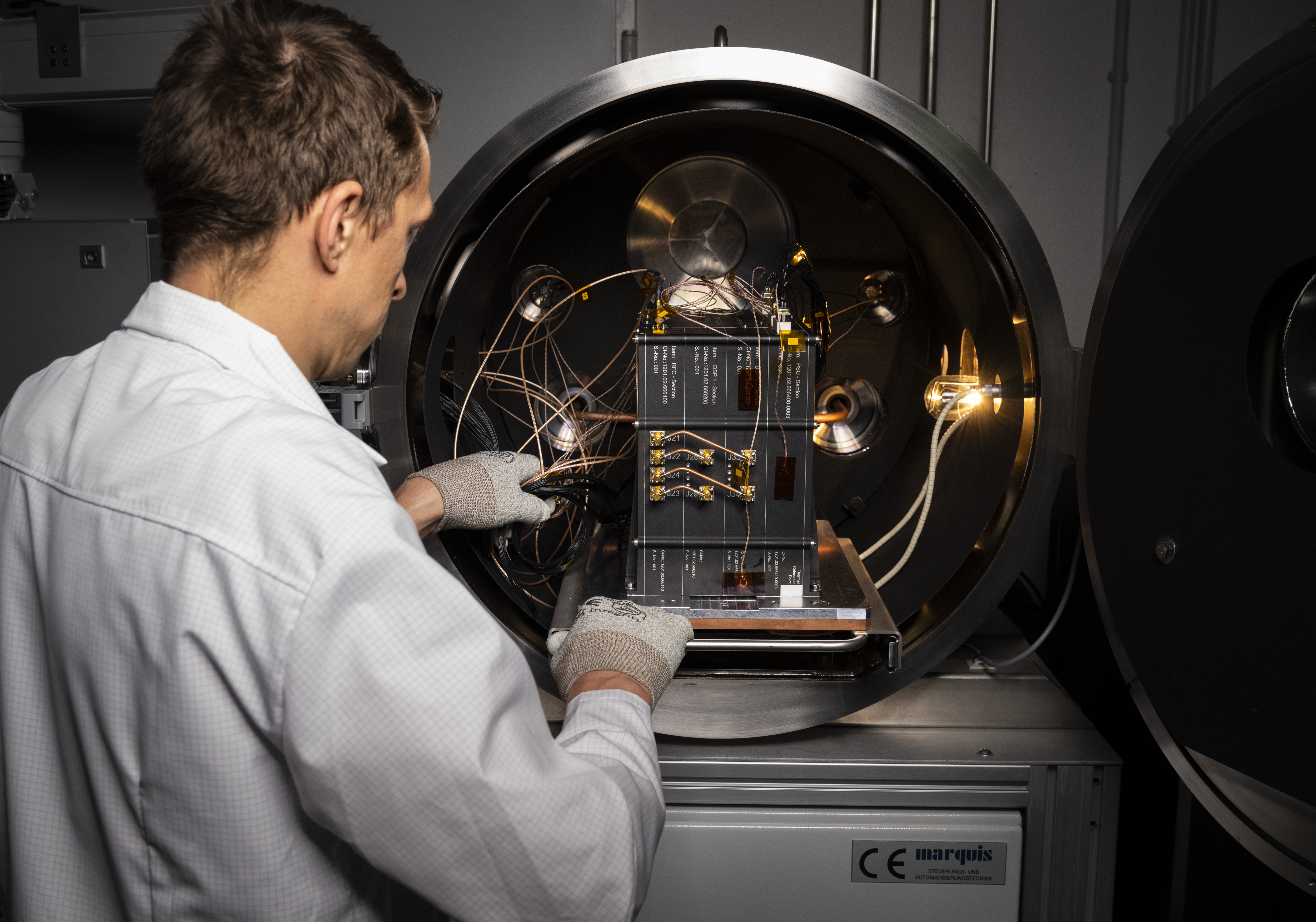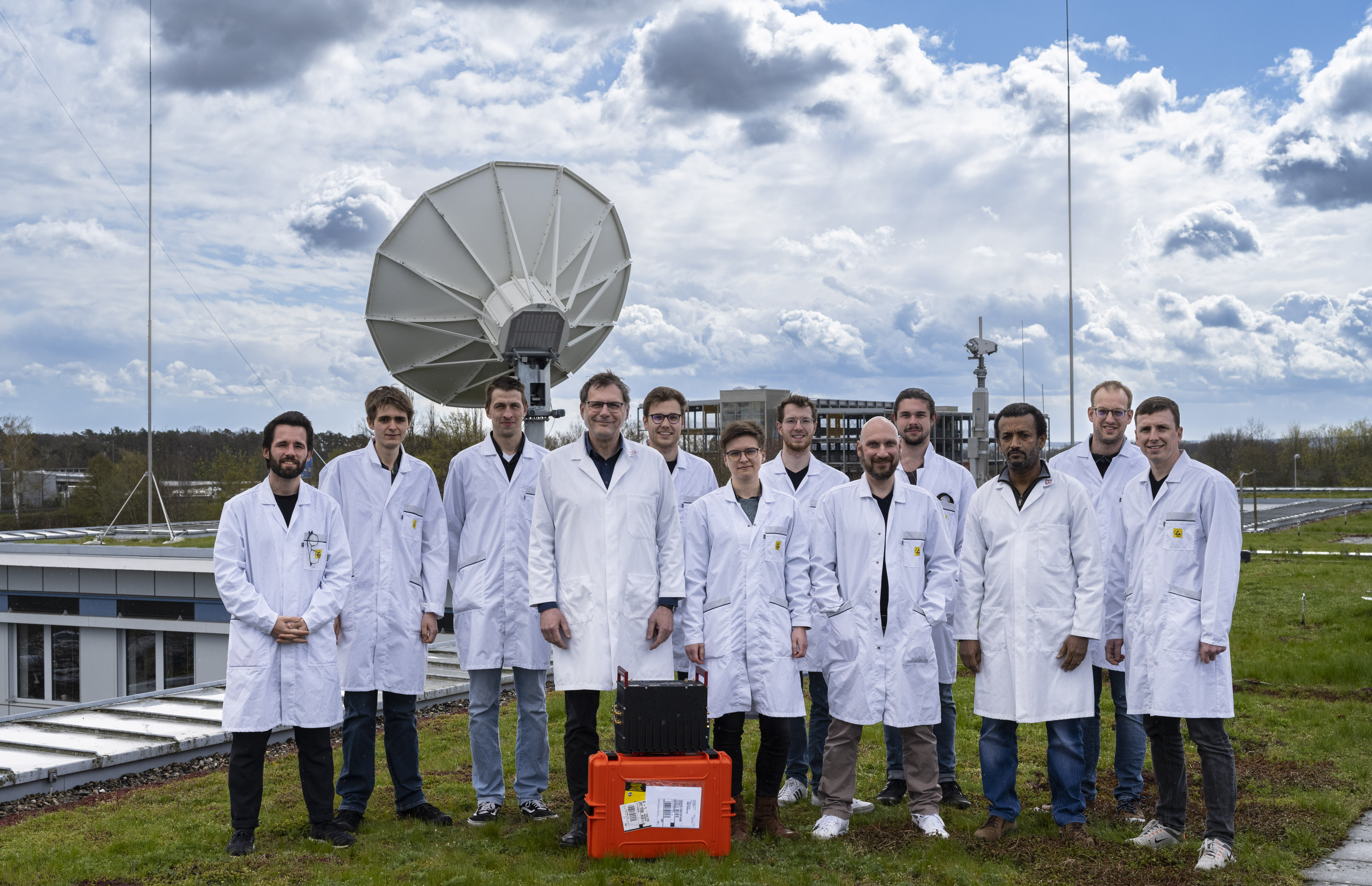For 15 years, Rainer Wansch and his team have been researching the idea of an on-board processor that can be controlled from Earth when it’s aboard a satellite orbiting the globe. Now the Fraunhofer On-Board Processor has arrived in space. A story of patience and perseverance.
When the fascination of space comes to life
July 7, 2023 | On-Board Processor in space. A story of patience and perseverance.

Let’s start with a little experiment. What do you think of first when you hear the word “space”? Planets, perhaps? Black holes? Or maybe astronauts? Ask Rainer Wansch this question, and his answer would probably be “Satellites, of course!” These flying objects are far away from us and yet always so near, constantly circling the globe. “Why send people into space? I think that makes sense in only a few instances,” Wansch says. But building devices that fly at altitudes of more than 500 kilometers, that can reach and connect many individuals at once – that’s what excites the man who has been a researcher at Fraunhofer IIS since 1996.
Once the Heinrich Hertz satellite climbs toward the heavens in 2023, enthusiasm turns into reality. The waiting is over. The Fraunhofer On-Board Processor (FOBP), a core component of the satellite, is now in space. This represents the culmination of one of the most important projects in Wansch’s scientific career so far. It was a project that succeeded in part because his team persevered even when things got complicated.
Imagine we’re back in 2008: smartphones are still a world novelty, the global cellular standard is 3G, and Germany is hatching a plan to venture back out onto the communications satellite market. Heinrich Hertz is the name of the mission that will put a platform into space for research. In theory, anyway. But big ideas can often be realized only by breaking them down into many small ones. What should the satellite look like, how should it be equipped, what should it be capable of – in short, how can the Heinrich Hertz satellite be brought to life? Industry and research are gearing up; the race for the best ideas is on.
The birth of the on-board processor
Fraunhofer IIS wants in on the collective brainstorming. In 2008, the institute looks a bit different than it does today. Its director is Heinz Gerhäuser. You would look for a Communication Systems division in vain; instead, you will find individual departments with names like Telecommunications orHigh Frequency Technology. Rainer Wansch is not yet a department head, but a group manager who works primarily with antennas.
He is also one of the people coordinating the pooling of Fraunhofer ideas. “At the institute, we thought about what the technologies on the satellite should be capable of,” Wansch recalls. Ultimately, a list of five proposals emerges. There is talk of phased arrayantennas, magnetic field sensors, as well as an on-board processor. The latter would not only process signals digitally, but also ensure that the payload can be controlled from the ground at any time. Because technological progress on Earth never stops, the satellite can be reprogrammed accordingly to always keep it at the cutting edge of technology, even in space.
Backnang, a small town near Stuttgart, hosts a workshop in 2009 that will decide the future of the Heinrich Hertz satellite. Which of the many ideas will prevail, which will be allowed into space and which will have to stay on the ground? About 150 representatives from the space and satellite industries have gathered to pitch their proposals. One of them is Rainer Wansch. Four out of five proposals prepared by Fraunhofer IIS don’t make it through the selection process, but the fabled white smoke rises above the on-board processor. “That’s when the hard work started,” Wansch says.
Through the maze
Science is rarely a linear process that can be determined from start to finish. Instead, it tends to move in waves, in ups and downs, in questions that lead to answers and answers that lead back to questions. It’s something like wending your way through a corn maze. Dead ends and winding paths lurk everywhere, forcing you back to your starting point over and over again. And it’s not always clear what’s around the next corner.
It’s something that Wansch and his team are soon to experience. They have to delve intothe logicof space travel, immersing themselves in reading up on the terminology, the forms, the documentation. Proving, justifying, proposing. “It was a steep learning curve,” he says. They have ordered field-programmable gate arrays (FPGAs), a key element of the FOBP, from the United States, but these exports are under tight control. Wansch’s team applies for and receives special permits, and searches for a secret location where they can store the circuits. “At the time the FPGAs arrived, we all looked much younger,” Wansch jokes.
When construction of the FOBP finally begins in 2012, one question hovers over all the others like the sword of Damocles. It’s a question that every component of the Heinrich Hertz satellite must answer: All well and good if it works on the ground – but can it survive the extreme conditions of space? For example: “We had one bit of software that suddenly wouldn’t start up at zero degrees Celsius, even though it had worked just fine at −20 or +20 degrees,” Wansch says. This job thus calls for detail work. And patience.
Suddenly, a core component
March 2017: the national satellite conference is being held in Bonn, but the German communications satellite is still on the ground. The launch, originally scheduled for 2015, had to be postponed. Something has changed in the meantime, as Wansch notices during the conversations he has at the conference. Some of the components that prevailed at the Backnang workshop have since been launched into space on other satellites. Wansch and his team are gradually becoming aware that their idea, once one among many, is suddenly becoming more and more central to the mission. The further the launch is pushed back, the more significant the FOBP seems to become. Two years later, Wansch attends the same conference and introduces the on-board processor as a platform that enables experimentation with 5G. “Much more so than we ever would have thought,” he says today. Fraunhofer IIS scientists have grown along with the FOBP. And the FOBP with them.
Although this article repeatedly mentions “the team,” that doesn’t necessarily refer to the same roster of individuals. Wansch himself speaks of three generations that have served on the project over the years. The first generation handled conceptualization and design; the second generation, construction and implementation. And finally, the third generation did testing, testing and then more testing – and is still working at Fraunhofer IIS today. As so often in life, persistence, especially across generations, eventually pays off. In the fall of 2020, while the coronavirus pandemic has a firm grip on the country, the FOBP can finally be let loose. Major tests are still ongoing, but now in tandem with the other Heinrich Hertz components. Temperature, shock, vibration. Time after time, the researchers find themselves on the road in Germany. “We had to prove over and over again: Is it still working?” Wansch says. It is.
Scientists who had the chance to conduct research in space at a young age, on projects that subsequently become a common theme throughout their careers, have always fascinated Wansch. The FOBP has given this fascination life. “My goal is to make the world down here on the ground a better place,” he says. This is another reason why the project is far from over. Quite the opposite, in fact: in space, the FOBP will soon serve as a kind of laboratory that industry and research can book together with Fraunhofer IIS for their own experiments. “Now a different kind of anticipation will take hold,” Wansch says. Every experiment, every finding, every discovery could shine a little light ahead, bringing a bit more clarity until the contours form an overall picture and the future of satellite communications emerges.
Would you like to use the FOBP for your own experiments? Then go to: Fraunhofer On Board Processor
